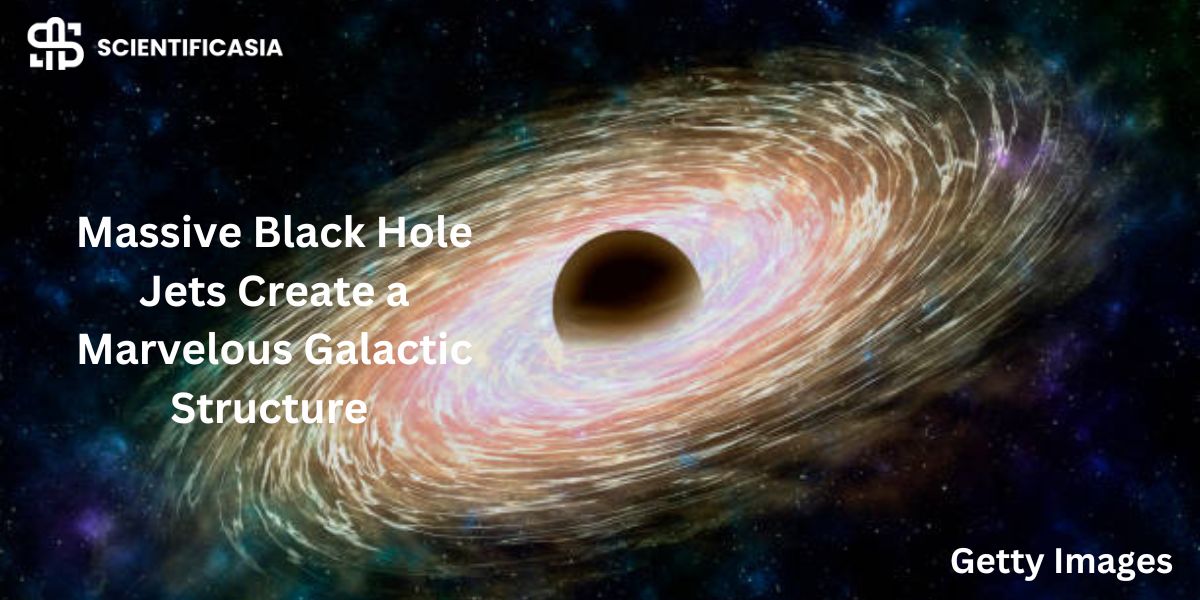The largest structure of galactic origin that we have yet seen has been carved out by a supermassive black hole that is ejecting astronomical jets into space.
It is named Porphyrion after the Greek mythological giant monarch, and its overall space-time span is around 7 megaparsecs. With a length of an astounding 23 million light-years, it is a substantial component of the cosmic web that links the entire universe.
Porphyrion demonstrates the close connections between big and small objects in the universe. We are witnessing a solitary black hole that generates a structure akin to cosmic filaments and voids,” said Caltech and Leiden University in the Netherlands astronomer Martijn Oei to ScienceAlert.
“The black hole would be 0.2 millimeters in size—the size of an amoeba or a mite on your skin—if we shrank the jets to match the size of the Earth. These enormous jets are amazing; it’s as though a single amoeba was capable of producing an energy fountain the size of the entire Earth.”
This is an amazing finding that begs a lot of concerns because it’s not an isolated incident. It comes after the galaxy Alcyoneus, whose jets stretch across 16 million light-years. This suggests that the elements needed to create “impossible” black hole jets—so massive that scientists formerly believed they were impossible to exist—might actually be very common in the universe. We still don’t fully grasp the formation mechanics of astrophysical jets produced by black holes.
We know that during a feeding event, part of the material swirling around and falling onto the black hole from the inner rim of the disk gets deflected and accelerated along lines of magnetic field to the poles, where it is propelled into space as strong jets of plasma and magnetic field, traveling at a substantial fraction of the speed of light.
Map: More than 20 states could witness the northern lights following a solar flare
The universe is full of these jets. Jets are a natural byproduct of the feeding and growing phases that supermassive black holes go through. However, Alcyoneus and Porphyrion’s jets pose a number of difficulties.
First, we must acknowledge that producing such massive jets would need the black hole to feed constantly for around a billion years, which is not common but clearly not impossible given the data. This suggests a massive reserve of material.
The jets’ length is the other. Porphyrion is the result of our 7.5 billion-year time travel back in time, when interstellar medium was denser than it is now.
Furthermore, a jet is increasingly unstable the longer it expands. Upon introducing an instability, the jet should disintegrate.
According to Oei, both theoretical calculations and numerical simulations of jet physics indicate that jets are inherently unstable structures—once disrupted, the disturbances tend to intensify rather than fade.
“The jets are eventually destroyed. Thus, an approximate “upper limit” to jet expansion is likely set, though we’re not sure where it is, along with the jets’ restricted fuelling time (which, however, can extend to billions of years!) and such (magneto)hydrodynamical instabilities.”
It is unclear how the jets of Porphyrion and Alcyoneus managed to stay steady across such enormous stretches of space-time.
NASA Invites Space Enthusiasts to ‘Observe the Moon Night’ on September 14
However, they might be providing us with some hints regarding the composition of the Universe. The cosmic web is a structure that spans all epochs of space-time. It is a massive system of filaments made up of dark matter, which gravitationally attracts galaxies, the hubs of galaxy clusters where these filaments converge, and the enormous gaps that exist in between the filaments.
Based on the team’s estimations, the length of Porphyrion’s jets is approximately 66% of the radius of the void that Porphyrion was sitting in at that particular moment.
This implies that the cosmic web may be shaped in part by these mega-jets. According to the researchers, this might be the cause of the magnetic field structures and unusually high temperatures observed in voids. The planes may have dropped these features at that location.
This is particularly intriguing because the black hole is an active radiative mode black hole, which means it is producing a lot of radiation and is a type that was frequently observed in the early Universe. This suggests that the cosmic web was shaped by a large number of massive jets that were present in the early Universe and may have been underestimated.
The study team thinks that the universe may be brimming with these galaxies even later.
“I think galaxies with giant jets are more common than we realize,” Oei stated.
This is due to the fact that as massive jet systems get bigger, they become more difficult to monitor. Additionally, in the farther cosmos, they are more difficult to notice. Thus, the current limit of our instrumental capabilities is the number of gigantic jets that can be observed. In the upcoming years, I anticipate that many more galaxies with massive jets will be discovered as instrumentation advances.”
And perhaps some answers to these lovely, perplexing questions to go along with them.
This research has been published on Nature.
Scientists Solve Mystery of 650-Foot Mega-Tsunami That Shook Earth for 9 Days
















